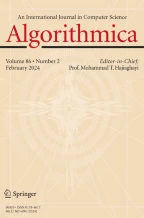Abstract
It is well-known that the class of sets that can be computed by polynomial size circuits is equal to the class of sets that are polynomial time reducible to a sparse set. It is widely believed, but unfortunately up to now unproven, that there are sets in \({\mathrm{EXP^{NP}}}\), or even in \({\mathrm{EXP}}\) that are not computable by polynomial size circuits and hence are not reducible to a sparse set. In this paper we study this question in a more restricted setting: what is the computational complexity of sparse sets that are selfreducible? It follows from earlier work of Lozano and Torán (in: Mathematical systems theory, 1991) that \({\mathrm{EXP^{NP}}}\) does not have sparse selfreducible hard sets. We define a natural version of selfreduction, tree-selfreducibility, and show that \({\mathrm{NEXP}}\) does not have sparse tree-selfreducible hard sets. We also construct an oracle relative to which all of \({\mathrm{EXP}}\) is reducible to a sparse tree-selfreducible set. These lower bounds are corollaries of more general results about the computational complexity of sparse sets that are selfreducible, and can be interpreted as super-polynomial circuit lower bounds for \({\mathrm{NEXP}}\).
Similar content being viewed by others
Notes
Formally, the reader might notice, these questions are independent. They are related however as follows. If \({\mathrm{EXP}}^\mathrm{NP}\) or even \({\mathrm{NEXP}}\) has polynomial size circuits then \({\mathrm{P}}\ne {\mathrm{NP}}\) follows. Therefore, it seems that it should be easier to settle the former question, in the negative, than it does to settle the latter.
In several places in this paper we use “optimal” where this is not an exact statement. If we prove a problem to be in \({\mathrm{NEXP}}\) and show an oracle relative to which it is not in \({\mathrm{EXP}}\) then it could still be in many intermediate classes, and even a non-relativizing proof might still show it to be in \({\mathrm{EXP}}\). Though we always make the exact meaning of optimal precise in theorems following the statement, the reader should be cautioned.
Here \(S_x^{M}\) resp. T denote the nodes of the graphs \(S_x^{S,M}\), T.
A set S is called P-selective if there exists a polynomial time function f such that \(f(x,y)\in \{x,y\}\) and \([x\in S\vee y\in S]\Rightarrow f(x,y)\in S\).
References
Agrawal, M., Arvind, V.: Quasi-linear truth-table reductions to p-selective sets. Theor. Comput. Sci. 158, 361–370 (1996)
Balcázar, J., Díaz, J., Gabarró, J.: Structural Complexity I. Springer, Berlin (1988)
Buhrman, H., Fortnow, L., Thierauf, T.: Nonrelativizing separations. In: IEEE Conference on Computational Complexity. IEEE Computer Society Press, pp. 8–12 (1998)
Berman, L., Hartmanis, H.: On isomorphisms and density of NP and other complete sets. SIAM J. Comput. 6, 305–322 (1977)
Beigel, R., Kummer, M., Stephan, F.: Approximable sets. Inf. Comput. 120(2), 304–314 (1995)
Buhrman, H., Torenvliet, L.: P-selective self-reducible sets: a new characterization of P. J. Comput. Syst. Sci. 53(2), 210–217 (1996)
Fortnow, L., Klivans, A.: NP with small advice. In: Proceedings of the 20th IEEE Conference on Computational Complexity. IEEE Computer Society Press, pp. 228–234 (2005)
Faliszewski, P., Ogihara, M.: Separating the notions of self- and autoreducibility. In: MFCS, pp. 308–315 (2005)
Hemaspaandra, L.A., Torenvliet, L.: Theory of Semi-Feasible Algorithms. Monographs in Theoretical Computer Science. Springer, Heidelberg (2002)
Ko, K.-I.: On self-reducibility and weak P-selectivity. J. Comput. Syst. Sci. 26, 209–211 (1983)
Ko, K., Schöning, U.: On circuit-size and the low hierarchy in NP. SIAM J. Comput. 14(1), 41–51 (1985)
Lozano, A., Torán, J.: Self-reducible sets of small density. J. Math. Systems Theory 24(1), 83–100 (1991)
Meyer, A.: Oral communication, cited in [4] (1977)
Mocas, S.: Separating exponential time classes from polynomial time classes. PhD thesis, Northeastern University (1993)
Ogihara, M.: Polynomial-time membership comparable sets. SIAM J. Comput. 24(5), 1168–1181 (1995)
Ogiwara, M., Watanabe, O.: On polynomial time bounded truth-table reducibility of NP sets to sparse sets. SIAM J. Comput. 20, 471–483 (1991)
Papadimitriou, C.H.: Computational Complexity. Addison Wesley, Boston (1994)
Selman, A.: P-selective sets, tally languages, and the behavior of polynomial time reducibilities on NP. Math. Syst. Theory 13, 55–65 (1979)
Selman, A.: Analogues of semicursive sets and effective reducibilities to the study of NP complexity. Inf. Control 52(1), 36–51 (1982)
Shaltiel, R., Umans, C.: Pseudorandomness for approximate counting and sampling. Technical report TR04-086, ECCC (2004)
Wagner, K.: Bounded query computations. In: Proceedings of 3rd Structure in Complexity in Conference. IEEE Computer Society Press, pp. 260–278 (1988)
Wilson, C.B.: Relativized circuit complexity. J. Comput. Syst. Sci. 31, 169–181 (1985)
Acknowledgements
We thank the anonymous referee for helpful suggestions. Funding was provided by Russian Foundation for Basic Research (Grant No. 16-01-00362), Russian Academic Excellence Project (Grant No. 5-100).
Author information
Authors and Affiliations
Corresponding author
Additional information
Publisher's Note
Springer Nature remains neutral with regard to jurisdictional claims in published maps and institutional affiliations.
Rights and permissions
About this article
Cite this article
Buhrman, H., Torenvliet, L., Unger, F. et al. Sparse Selfreducible Sets and Nonuniform Lower Bounds. Algorithmica 81, 179–200 (2019). https://doi.org/10.1007/s00453-018-0439-0
Received:
Accepted:
Published:
Issue Date:
DOI: https://doi.org/10.1007/s00453-018-0439-0
